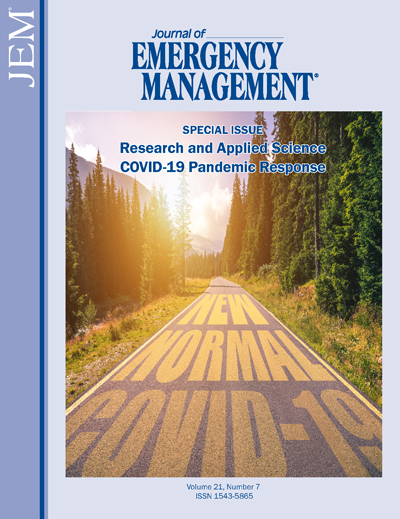Intention to vaccinate against COVID-19 and potential outreach strategies for a residential research university in Northeastern Ohio
DOI:
https://doi.org/10.5055/jem.0729Keywords:
vaccine hesitancy, Theory of Planned BehaviorAbstract
Introduction: A university’s understanding of student, faculty, and staff members’ intention to vaccinate against COVID-19 has been vital in returning safely to in-person education, research, and engagement with communities and professions. We employed a novel survey to describe intentions across subpopulations of one campus and consider key issues in their rationales for intentions and hesitancies.
Materials and methods: 1,077 surveys based on Theory of Planned Behavior were completed from randomly selected pools of undergraduate students, graduate students, part-time faculty, full-time faculty, and staff. Chi-Squared Automated Interaction Detection algorithm analysis provided paths for evaluation. Results and discussion: 83 percent of respondents said they would receive the vaccine at their first opportunity, while 5 percent said they would never get the vaccine; the remaining 12 percent wanted more evidence before getting the vaccine. Findings included negative health perceptions of the vaccine, misinformation on the process, as well as negative rhetorical responses differentiated between political partisanship and membership within the campus community, eg, faculty, staff, or student.
Implications: Universities seeking to raise campus vaccination rates should concentrate limited resources on the largest populations with the most opportunity to vaccinate. In this study, newer students, with conservative political views, represented a population of opportunity. Their formative beliefs may be influenced by messaging and in collaboration with students’ personal physician and/or friend groups. A theory-based approach leads to focused efforts for safer campuses and resumption/continuation of face-to-face interactions for students, faculty, and staff.
References
2020-21 Faculty Compensation Survey Results | AAUP: Available at https://www.aaup.org/2020-21-faculty-compensationsurvey-results. Accessed December 29, 2021.
Current Term Enrollment Estimates-National Student Clearinghouse Research Center: Available at https://nscresearchcenter.org/current-term-enrollment-estimates/. Accessed December 29, 2021.
Nietzel MT: Pandemic’s impact on higher education grows larger; now estimated to exceed $120 billion. Forbes.com. 2020. Available at https://www.forbes.com/sites/michaeltnietzel/2020/09/29/pandemics-impact-on-higher-education-grows-larger-now-estimated-toexceed-120-billion/?sh=54420ee422bd. Accessed December 29, 2021.
[Un]Classes | The University Akron: Available at https://www.uakron.edu/exl/unclasses/. Accessed June 6, 2021.
Ajzen I: The theory of planned behavior. Organiz Behav Hum Decis Process. 1991; 50: 179-211. DOI: 10.1016/0749-5978(91)90020-T.
Ajzen I: Constructing a theory of planned behavior questionnaire. 2005. Available at http://people.umass.edu/~aizen/pdf/tpb.measurement.pdf. Accessed August 29, 2022.
Xiao X, Wong RM: Vaccine hesitancy and perceived behavioral control: A meta-analysis. Vaccine. 2020; 38(33): 5131-5138. DOI: 10.1016/j.vaccine.2020.04.076.
Shay DK: Safety monitoring of the Janssen (Johnson & Johnson) COVID-19 vaccine—United States, March–April 2021. MMWR. Morbidity and Mortality Weekly Report. 2021; 70(18): 680–684. DOI: 10.15585/MMWR.MM7018E2.
Sutton S, French DP, Hennings SJ, et al.: Eliciting salient beliefs in research on the theory of planned behaviour: The effect of question wording. Curr Psychol. 2003; 22: 234–251. DOI: 10.1007/s12144-003-1019-1.
Lemon S, Roy J, Clark M, et al.: Classification and regression tree analysis in public health: Methodological review and comparison with logistic regression. Ann Behav Med. 2003; 26(3): 172-181. DOI: 10.1207/S15324796ABM2603_02.
KFF COVID-19 Vaccine Monitor: May 2021 | KFF. Available at https://www.kff.org/coronavirus-covid-19/poll-finding/kff-covid-19-vaccine-monitor-may-2021/. Accessed June 6, 2021.
Pastorino R, Villani L, Mariani M, et al.: Impact of COVID-19 pandemic on flu and COVID-19 vaccination intentions among university students. Vaccines (Basel). 2021; 9(2). DOI: 10.3390/vaccines90200:70.
Sharma M, Davis RE, Wilkerson AH: COVID-19 vaccine acceptance among college students: A theory-based analysis. Int J Environ Res Public Health. 2021; 18. DOI: 10.3390/ijerph1809:4617.
Here’s where that COVID-19 vaccine infertility myth came from—and why it is not true | henry ford LiveWell. Available at https://www.henryford.com/blog/2021/04/fertility-rumor-covid-vaccine. Accessed July 13, 2021.
Shih SF, Wagner AL, Masters NB, et al.: Vaccine hesitancy and rejection of a vaccine for the novel coronavirus in the United States. Front Immunol. 2021; 12(1). DOI: 10.3389/fimmu.2021.558270.
Dimock M: Where millennials end and generation Z begins. Pew Research Center. 2019. Available at https://www.pewresearch.org/fact-tank/2019/01/17/where-millennials-end-and-generation-zbegins/. Accessed June 30, 2021.
Darley JM, Latane B: Bystander intervention in emergencies: Diffusion of responsibility. J Pers Soc Psychol. 1968; 8(4): 377-383. DOI: 10.1037/h0025589.
Flu Shots: COVID-19 and the holidays: Winter wellness survey findings. 2020. Available at https://www.gohealth.com/report-flu-shotscovid-19-vaccine-and-holiday-gatherings/. Accessed June 30, 2021.
Thompson B: NBC poll: 26 percent of gen Z say they won’t get COVID-19 vaccine. 2021. Available at https://www.wcnc.com/article/news/health/coronavirus/vaccine/gen-z-covid-vaccine-skip-gettingshot-why/275-38829b1e-e83b-4fc9-a790-05b557cb54d6. Accessed June 30, 2021.
COVID-19 School Mandates for Masks: Vaccines are blocked in more states—WSJ. Available at https://www.wsj.com/articles/covid-19-school-mandates-for-masks-vaccines-are-blocked-in-morestates-11626433201. Accessed July 17, 2021.
Mo PKH, Luo S, Wang S, et al.: Intention to receive the COVID-19 vaccination in China: Application of the diffusion of innovations theory and the moderating role of openness to experience. Vaccines (Basel). 2021; 9(2): 129-115. DOI: 10.3390/VACCINES9020129.
Rogers EM: Diffusion of Innovations. New York: Free Press, 2003.
Saurwein F, Spencer-Smith C: Combating disinformation on social media: Multilevel governance and distributed accountability in Europe. Digit Journal. 2020; 8(6): 820-841. DOI: 10.1080/21670811.2020.1765401.
Walter N, Brooks JJ, Saucier CJ, et al.: Evaluating the impact of attempts to correct health misinformation on social media: A meta-analysis. Health Commun. 2021; 36(13): 1776-1784. DOI: 10.1080/10410236.2020.1794553.
Gisondi MA, Barber R, Faust JS, et al.: A deadly infodemic: Social media and the power of COVID-19 misinformation. J Med Internet Res. 2022; 24(2): e35552.
Rothgerber H, Wilson T, Whaley D, et al.: Politicizing the COVID-19 pandemic: Ideological differences in adherence to social distancing. PsyArXiv. 2020; April 22. DOI: 10.31234/osf.io/k23cv.
Duong D: What’s important to know about the new COVID-19 variants? CMAJ. 2021; 193(4): E141-E142. DOI: 10.1503/CMAJ.1095915.
Centers for Disease Control and Prevention: Considerations for institutions of higher education | CDC. Available at https://www.cdc.gov/coronavirus/2019-ncov/community/colleges-universities/considerations.html. Accessed July 22, 2020.
Downloads
Published
How to Cite
Issue
Section
License
Copyright 2007-2025, Weston Medical Publishing, LLC and Journal of Emergency Management. All Rights Reserved.






